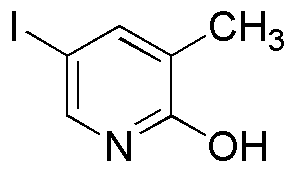2-Hydroxy-3-methyl-5-iodopyridine is widely utilized in research focused on:
- Pharmaceutical Development: This compound serves as an important intermediate in the synthesis of various pharmaceuticals, particularly those targeting neurological disorders, due to its ability to interact with specific receptors in the brain.
- Organic Synthesis: It is employed as a building block in organic synthesis, allowing chemists to create complex molecules more efficiently, which is crucial in developing new materials and chemicals.
- Agricultural Chemicals: The compound is used in formulating agrochemicals, enhancing crop protection products by improving their efficacy against pests and diseases, thus supporting sustainable agriculture.
- Analytical Chemistry: It acts as a reagent in various analytical techniques, helping researchers detect and quantify other substances in complex mixtures, which is vital in quality control processes.
- Material Science: This chemical is explored in the development of novel materials, including polymers and coatings, due to its unique properties that can enhance performance and durability.
General Information
Properties
Safety and Regulations
Applications
2-Hydroxy-3-methyl-5-iodopyridine is widely utilized in research focused on:
- Pharmaceutical Development: This compound serves as an important intermediate in the synthesis of various pharmaceuticals, particularly those targeting neurological disorders, due to its ability to interact with specific receptors in the brain.
- Organic Synthesis: It is employed as a building block in organic synthesis, allowing chemists to create complex molecules more efficiently, which is crucial in developing new materials and chemicals.
- Agricultural Chemicals: The compound is used in formulating agrochemicals, enhancing crop protection products by improving their efficacy against pests and diseases, thus supporting sustainable agriculture.
- Analytical Chemistry: It acts as a reagent in various analytical techniques, helping researchers detect and quantify other substances in complex mixtures, which is vital in quality control processes.
- Material Science: This chemical is explored in the development of novel materials, including polymers and coatings, due to its unique properties that can enhance performance and durability.
Documents
Safety Data Sheets (SDS)
The SDS provides comprehensive safety information on handling, storage, and disposal of the product.
Product Specification (PS)
The PS provides a comprehensive breakdown of the product’s properties, including chemical composition, physical state, purity, and storage requirements. It also details acceptable quality ranges and the product's intended applications.
Certificates of Analysis (COA)
Search for Certificates of Analysis (COA) by entering the products Lot Number. Lot and Batch Numbers can be found on a product’s label following the words ‘Lot’ or ‘Batch’.
Numéro de catalogue
Numéro de lot/série
Certificates Of Origin (COO)
This COO confirms the country where the product was manufactured, and also details the materials and components used in it and whether it is derived from natural, synthetic, or other specific sources. This certificate may be required for customs, trade, and regulatory compliance.
Numéro de catalogue
Numéro de lot/série
Safety Data Sheets (SDS)
The SDS provides comprehensive safety information on handling, storage, and disposal of the product.
DownloadProduct Specification (PS)
The PS provides a comprehensive breakdown of the product’s properties, including chemical composition, physical state, purity, and storage requirements. It also details acceptable quality ranges and the product's intended applications.
DownloadCertificates of Analysis (COA)
Search for Certificates of Analysis (COA) by entering the products Lot Number. Lot and Batch Numbers can be found on a product’s label following the words ‘Lot’ or ‘Batch’.
Numéro de catalogue
Numéro de lot/série
Certificates Of Origin (COO)
This COO confirms the country where the product was manufactured, and also details the materials and components used in it and whether it is derived from natural, synthetic, or other specific sources. This certificate may be required for customs, trade, and regulatory compliance.


